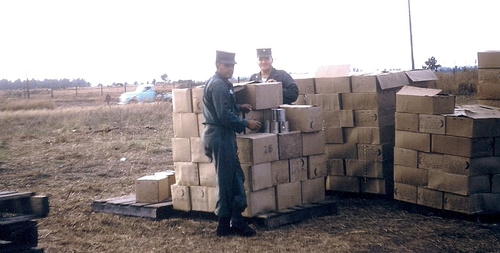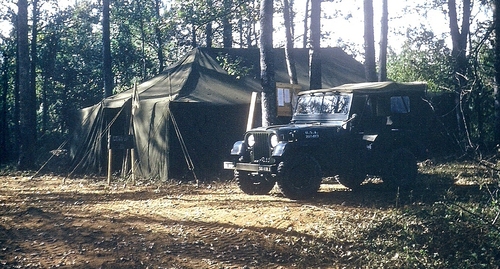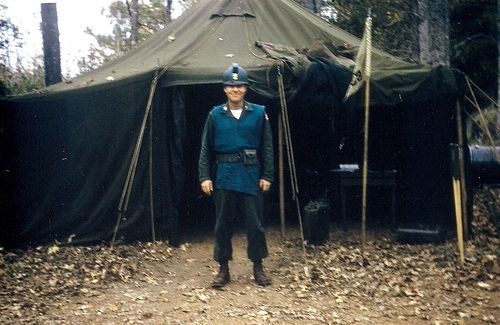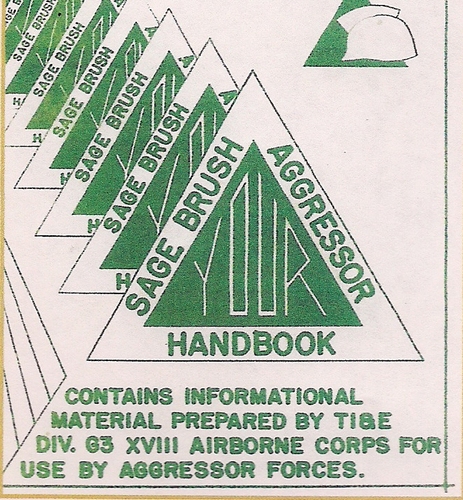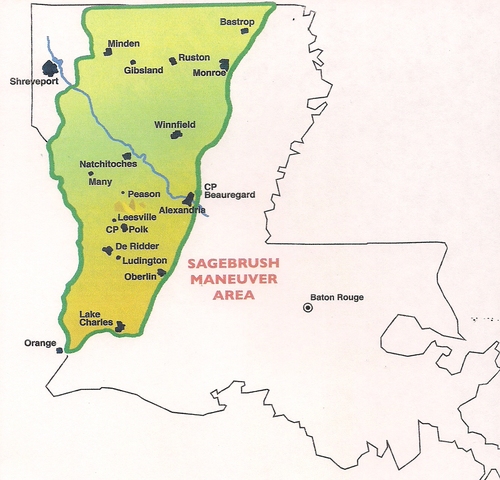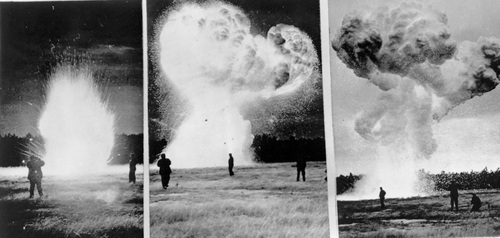.JPG)
By Rickey Robertson
In the history of the United States Army, the Great Louisiana Maneuvers of 1941 are still well remembered and many of the combat tactics learned in those maneuvers are still taught in the Command and General Staff School. The 1955 Louisiana maneuvers, known as EXERCISE SAGE BRUSH, however eclipsed this previous maneuver in one aspect; it was designed to test simulated combat conditions in an atomic war. The forces from various divisions and units again camped throughout Louisiana just as their predecessors did in 1941, in ever town, village, communities, and the countryside, and throughout Sabine Parish. Living here in the little community of Peason and Peason Ridge many of the battles and engagements were fought right here. By capturing and holding Peason and Peason Ridge, the invading armies could fan out and attack Leesville, DeRidder, and Lake Charles.
In comparison to the Louisiana Maneuvers of 1941 where over 470,000 troops participated, EXERCISE SAGE BRUSH involved 140,000 various troops; 110,000 were US Army and 30,000 US Air Force personnel. It became the largest post-World War II maneuvers conducted in the United States. Major unites included the 9th Field Army (Provisional) comprised of the 1st Armored Division, 3rd Infantry Division, and a new unit to be tested, the 77th Special Forces Group. This army had as air support the 366th and 405th Fighter Bomber Wing, 345th Light Bomber Group, 363rd TAC Recon Wing, 507th TAC Air Command Group and the 11th Tactical Missile Flight. The Aggressor Forces were comprised of the XVIII Airborne Corps, 4th Armored Division, 82nd Airborne Division, and the 11th Armored Cavalry Regiment. Air support for the Aggressor Forces included the 312th Fighter Bomber Wing, 479th Fighter Day Wing, 461st Light Bomber Wing, 363rd TAC Recon Wing, and the 507th TAC Air Command Control Wings. The residents of the maneuver area here in Louisiana saw new equipment and tactics that had evolved from the previous maneuvers fourteen years earlier. Look out Louisiana, here we come!!!
EXERCISE SAGE BRUSH ran from 31 October 1955 until 15 December 1955, longer than most army training maneuvers. Its mission was to train the various units in "atomic attacks" for both the US Army and the Aggressor Forces. The maneuvers began with a simulated atomic bomb set off at Fort Polk. Residents of especially Sabine and Vernon Parishes encountered giant 280mm atomic cannons capable of firing atomic artillery shells. The new US Army H-19 helicopters used to transport troops into combat areas also fascinated them. People drove up to the camps just to look at these flying contraptions! Aggressor Forces were constantly attacking the United States forces in an attempt to defeat them. The 82nd Airborne (Aggressor Forces) hit the ground fighting and almost overran the US forces with two combat jumps landing in an area between Eagle Hill and Lyles Creek at Peason and on Peason Ridge Artillery Range.
Armored units faced heavy traffic congestion with miles long traffic jams as mechanized units attempted to attack northward. In late November 1955 to early December 1955 torrential downpours held up military and civilian traffic. People could not travel to town, to church, and school buses could not pick up or deliver students to the various schools in Sabine Parish; kids who lived at Peason and attending Plainview High School had a difficult journey each day just trying to get through the Peason-Plainview Road. If buses got stuck or could not climb the Ivy and Ed Dowden Hill people got out and pushed or army vehicles pulled them up. The severe rainfall meant US Air Force units could not provide the close air support needed by the ground units, but occasionally the jets screamed over the tree tops. There were not enough air-to-ground radio communications, and more engineer units were needed to keep roads, bridges, and culverts operational during the heavy rainfall and during the "atomic attacks", and more transport aircraft were needed to supply airborne troops. This was the first maneuvers held since the United States had nuclear weapons and many new problems had to be worked out with locations of the new atomic artillery units and their ammunition supply and storage dumps. But all these problems were addressed during EXERCISE SAGE BRUSH and would be corrected; new equipment and the tactics learned during EXERCISE SAGE BRUSH would soon be used in a new war in a country called Vietnam .
The older folks remembered the 1941 maneuvers and the huge number of troops continuously on the move - but that was minor compared to the number of motor vehicles used during Exercise Sage Brush. The folks saw everything differently during Sage Brush. Heavy tanks replaced the early light tanks, jeeps had replaced the cavalry horses for recon duties, weapons carriers were in and out of the woodlands, bogs, and swamps, and in the air, troop carrier aircraft, jets, and helicopters filled the sky. But the scariest of all were the heavy atomic cannons. Veterans of World War II remembered the unknown certainties of the atomic bomb and here were weapons in the field that could deliver atomic projectiles onto the battlefield.
Here at Peason helicopters landed in many places and troops would fan out and attack their objectives. We did not know it at the time, but this was the first of the "Sky Cavalry Concept" to be tried. The lessons learned with the helicopters were used by the 1st Cavalry Division in Vietnam in the Ia Drang Valley very successfully.
With the roads virtually destroyed by the heavy military traffic, engineer units were in great demand. I recently interviewed retired SGT. MAJOR Edward Stanberry of Huntington Tx. about his days during Exercise Sagebrush. He was a young platoon sergeant in the 21st Engineer Battalion and his unit moved continuously trying to keep the road network open. At a collapsed bridge Sgt. Stanbery and his men captured an Aggressor tank. He and his unit stayed nearly two extra months after the maneuvers attempting to help rebuild the destroyed road network in the maneuver areas.
Let's look back and thank the service members who served during Exercise Sage Brush, for they stood up for freedom during the days of the Cold War and the possible attack by Soviet Russia. These service men upheld the fighting traditions of its predecessors and let's tell them "thank you for your service to our nation during Exercise Sage Brush" !
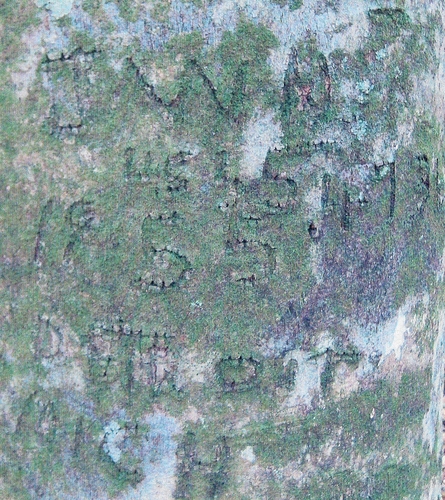
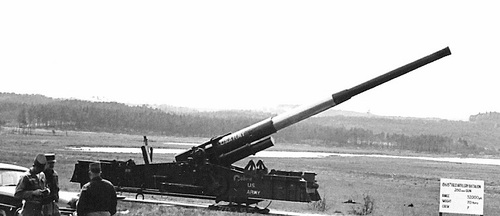
-jpg_rdax_500x349.jpg)
-jpg_rdax_500x355.jpg)
